DIY ventilation in the workshop: options and principles for arranging an air exchange system
Work associated with the formation of dust, the release of toxic gases, fumes, require the arrangement of a workplace and premises with an exhaust system. In most cases, do-it-yourself ventilation in the workshop is the most affordable way to solve the problem.
There are various options for constructing air exchange systems. We will help you navigate in their diversity, consider the features of building ventilation for each type of workshop. We will analyze the most effective and affordable options for self-installation.
The content of the article:
Types of ventilation systems in the workshop
By the method of air circulation in the room, two main types of ventilation are distinguished:
- natural;
- forced.
In the first case, the movement of air occurs due to the temperature difference indoors and outdoors.
And in the second circulation is provided by fans, creating in the workshop overpressure or vacuum. Such ventilation is also called mechanical ventilation.
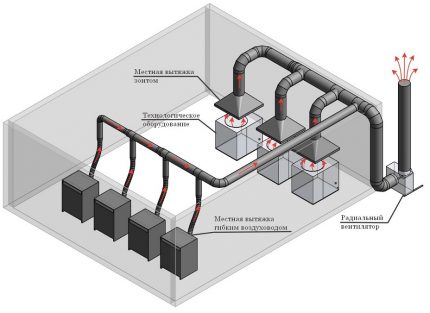
In turn, forced is of the following types:
- exhaust;
- supply;
- combined.
Exhaust ventilation ensures the removal of harmful gases, vapors, while clean air enters the workshop naturally. Supply, on the contrary, creates excessive pressure inside the room due to the intake of street air, and the exhaust is squeezed out of the workshop out through natural openings, cracks. If necessary, the input stream can be heated, cleaned, or moistened.
Combined workshop ventilation system called supply and exhaust. Depending on the relative position of the air supply and exhaust channels, circulation can occur by displacement or mixing.
If the supply fans are below, then the rising cold air displaces the warmer. With the upper location of the inlet channel, the cold stream is distributed throughout the room, sinking down, mixed with warmer. Then the exhaust air is removed by an exhaust duct.
Depending on the organization method, ventilation in the workshop is divided into two types:
- local
- centralized.
The first is used to remove harmful substances directly from the workplace. It is advantageous to use it for localization of pollution when units of equipment are removed from each other throughout the entire area of the room.

For small workshops with a more compact arrangement of machines it is advisable to install a centralized hood.
Also apply hybrid ventilation optionswhen part of the machines is connected to a common system, and part has local filtering. In some cases, in principle, they prefer only local systems to prevent the dispersal of fine dust and other toxic substances throughout the workshop.
Features of the arrangement of ventilation in the workshop
Work in the workshop is associated with the presence of toxic and unhealthy substances in the air. The design and construction of ventilation in such rooms depends on the type of work and the nature of the harmful factors.
Consider the main features that affect the configuration and parameters of ventilation systems for different types of workshops.
#1. Dust removal in a carpentry workshop
Fine dust is the main problem of woodworking workshops. Such a suspension of particles can be in the air all 24 hours, although it is not noticeable to the eyes, but is inhaled by the lungs. In addition, it settles on all surfaces. With any draft or engine start of machines, tools, it again appears in the air.
Organization of a dust extraction system (aspiration) complicated by the presence of a large number of dust sources and different fractions of chips. For this reason, it is required to supply suction hoses with individual filtration to each machine.
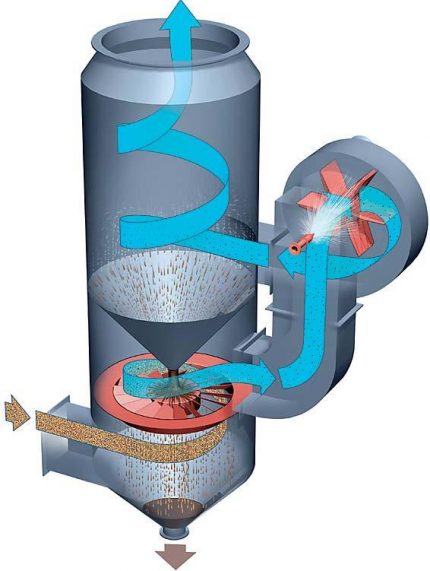
But, in addition to harmful effects on breathing, wood dust still has fire and explosive properties. Which makes increased demands on ventilation systems in terms of eliminating electrostatics and grounding structures.
# 2 Car air cleaning
Car service workshop refers to rooms with high air pollution. The constant presence of exhaust gases, carbon monoxide and nitrogen, aerosols, gasoline vapors, paints and other technical fluids places special demands on the performance of the ventilation system. The power of the supply and exhaust unit is selected with a margin to ensure the pumping of the entire volume of the room with a recommended ratio of 20 - 30.
In addition, contaminated air must be filtered and discharged separately from the general ventilation pipe.
# 3 Ventilation of repair and blacksmith workshops
The products of electrode burning, smoke, cinder and dust released during welding and locksmithing work during cutting and metal processing require removal using local hoods.What is regulated GOST 12.3.003, SP 49.13330, POT R M 020-2001 [22],STO 221 NOSTROY 2.10.64-2013 and safety rules during construction, gas welding and electric welding works.
For manual electric welding, their approximate productivity is selected based on the provision of air exchange from 1500 to 4500 thousand m3* h / kg divided by the weight of electrodes burned in 1 hour.
In semi-automatic welding, the volume is increased to 1700 - 2000 thousand m3* h / kg.
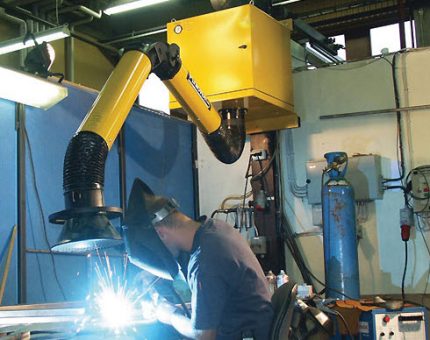
The general air circulation is distributed in the ratio of inflow to exhaust hood 1: 3 for the upper tier, and 2: 3 for the lower tier.
The ventilation feature of the blacksmith workshop is the need to remove excess heat and toxic gases. To do this, use local suction above the stoves and natural ventilation.
When calculating the performance of ventilation systems for all types of workshops at the recommended multiplicity, it is necessary to take into account heat loss in the cold season. The choice of maximum parameters will guarantee the rapid removal of harmful substances, but at the same time, it will require the cost of heating the supply air. Ifheat recovery not provided, it is better to stop the choice on the lower permissible limits of multiplicity.
Workshop ventilation options
In the search for the best ways to build ventilation for your own workshop, you have to review many possible options before you find the most suitable.
To facilitate this search, we will consider, as an example, the most successful, in our opinion, solutions for independent arrangement of ventilation in the workshop.
Option # 1 - exhaust ventilation from plastic pipes
For the implementation of this project the following were used: a used “snail” centrifugal fan with an electric motor of 2, 2 kW, a barrel of 40–50 liters with a mouth corresponding to the “snail” inlet, and sewer plastic pipes of 110 mm.
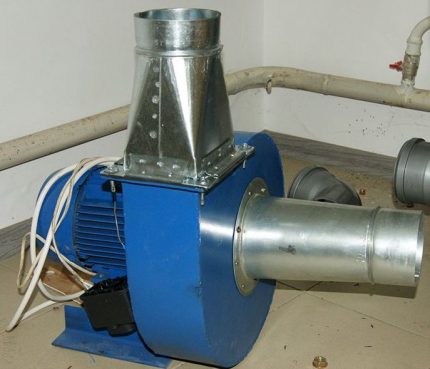
A few words about the material of the ducts. The use of plastic sewer pipes for ventilation is a fairly popular option, primarily due to the price. They are several times cheaper than plastic and steel air ducts for ventilation.
But sewer pipes have their drawbacks:
- they can not be used in places where the temperature can exceed +60 degrees;
- they do not have an antistatic coating, so it is not advisable to use them for chip and dust removal systems;
- their diameters do not meet the standards of ventilation systems, which makes it difficult to pair with other equipment.
Despite these shortcomings, in most cases,sewer pipes successfully used as ducts. The considered option of the device ventilation system from improvised materials was no exception.
In this project, all the main hood assemblies for the locksmith workshop were made by hand. Let us briefly describe the stages of the work done.
So, at first, overhaul and revision of the centrifugal fan was carried out. The refinement concerned the inlet pipe. More precisely, because of its absence, it was necessary to produce a new one from a small sealed barrel, the volume of which would allow the fan to pick up the necessary speed of the vortex flow.
A side hole was made in the barrel and a piece of plastic pipe was glued, taking into account aerodynamics, so that the input stream went along the inner circumference of the barrel.Then, an air duct made of plastic pipes was mounted under the ceiling in the center along the entire workshop.

The centrifugal fan creates a powerful vortex flow in the barrel, which ensures fast air circulation throughout the system. Its strength is so great that it keeps the saw blade of the grinder on the most distant air inlet.
The exhaust system parameters are as follows:
- engine power 2, 2 kW;
- fan speed 2800 rpm;
- productivity 1000 m3/ h - 1500 m3/ h;
- the time for extracting the entire volume of air from the workshop is 5 to 10 minutes.
The whole system has 6 air inlets closed with homemade adjustable plugs. They are made of regular plastic with cut out slots in the lid, and the same slots in the movable metal plate, fixed on one axis. With their mutual rotation, the air flow is regulated.
Option # 2 - a dust collector from the KAMAZ filter
Since factory dust extraction systems are quite expensive, home-made dust collectors based on air filters from large KamAZ trucks, tractors or combines are widely used.
Having supplemented such a filter with a fan, they get a good air purifier, which takes up a minimum of space and is easily transferred to any part of the workshop.
The performance of such a system is regulated by the selection of fan power. Such filters can clean the air volume from 500 to 1000 m3 per hour, depending on type. Fans with capacity up to 300 - 400 m can be connected to them.3/ h

Assembling an air purifier is quite simple. To do this, cut the flange, fix the pin on the axis to the length of the filter. Next, glue the fan to the flange and screw the entire structure to the filter.
Due to the simplicity of manufacture and low cost, such filters can be made several and significantly improve the air throughout the workshop.
Option # 3 - aspiration system in a carpentry workshop
The main role in the proposed dust removal system is played by the JET factory chip cleaner. The cost of such equipment, depending on the parameters, is 15 - 40 thousand rubles. Most models have a dust bag and a chip bag.
For this option, the best model JET DC-1200CK was selected with a paper filter element in the form of a removable drum. It is equipped with a manual device for internal cleaning, which allows you to remove the main dust without removing the filter.
Ventilation pipes were chosen to provide maximum protection against electrostatics and the lowest resistance to air flow. In the best way, twisted galvanized steel pipes meet these requirements.
During their installation with a multimeter, the reliability of electrical contact at the connection nodes was checked. If necessary, the contact was strengthened by two self-tapping screws from opposite sides. The entire pipeline was grounded. In addition, the joints were wrapped with aluminum tape for tightness.
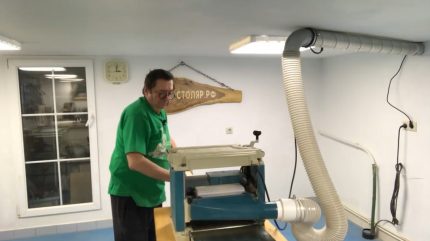
To reduce noise and dust, the exhaust system has been moved outside the workshop to an adjacent boiler room. The supply pipe is laid through a hole in the wall under the ceiling. The inlet pipe is fixed to the ceiling in the middle of the workshop. He is wearing a corrugated two-meter pipe made of transparent plastic.
In addition to aspiration, air exchange in the carpentry workshop is provided by supply and exhaust ventilation.
Conclusions and useful video on the topic
One of the options for hoods in the workshop:
Where is the best place for a chip pump? More about this in the next video:
Option to equip a mobile hood for the workshop:
The options discussed above do not cover the entire set of methods for independently constructing ventilation in the workshop. But, at least, they will help you choose the right direction for your own project and avoid a long trial and error path. Practice shows that a ventilation system of sufficient performance for the workshop can be completely designed and installed with your own hands.
Do you have questions about the ventilation device in the workshop? Or want to tell other users about how you organized an effective air exchange and dust removal system on your own, using improvised materials? Share your experience, ask questions to our experts - the comment block is located below this publication.

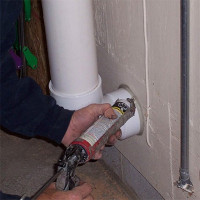 DIY ventilation in the apartment: an overview of the nuances of arranging the ventilation system
DIY ventilation in the apartment: an overview of the nuances of arranging the ventilation system  Inspection pit ventilation in a garage: specifics of arranging an air exchange system
Inspection pit ventilation in a garage: specifics of arranging an air exchange system  Basement ventilation in a private house: the best ways to arrange proper air exchange
Basement ventilation in a private house: the best ways to arrange proper air exchange  Is forced ventilation in the bathroom necessary: norms and stages of arranging efficient air exchange
Is forced ventilation in the bathroom necessary: norms and stages of arranging efficient air exchange 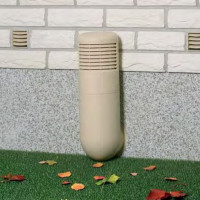 Ground floor ventilation: general arrangement technology + effective air exchange methods
Ground floor ventilation: general arrangement technology + effective air exchange methods 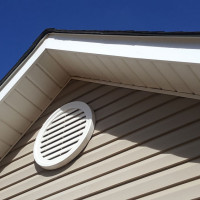 Ventilation in a private house through the pediment: arrangement options
Ventilation in a private house through the pediment: arrangement options  How much does it cost to connect gas to a private house: the price of organizing gas supply
How much does it cost to connect gas to a private house: the price of organizing gas supply  The best washing machines with dryer: model rating and customer tips
The best washing machines with dryer: model rating and customer tips  What is the color temperature of light and the nuances of choosing the temperature of the lamps to suit your needs
What is the color temperature of light and the nuances of choosing the temperature of the lamps to suit your needs  Replacement of a geyser in an apartment: replacement paperwork + basic norms and requirements
Replacement of a geyser in an apartment: replacement paperwork + basic norms and requirements